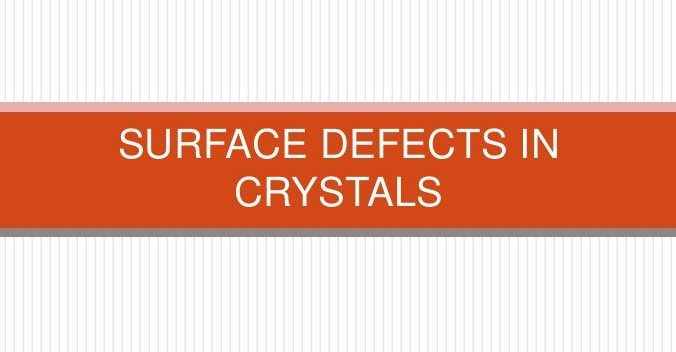Surface defects in solid crystals
Surface defects are the type of crystal defects in which solid crystal is divided into regions having different crystal structure and different crystallographic orientations. Surface defect is called two dimensional because the area between the regions is only just some atomic diameters.

There are four types of surface defects:
1.External surfaces: Most obvious boundaries are the outermost surface, along which the crystal structure terminates. The outermost atoms are bonded to least number of atoms i.e. outer most atoms are only linked to inner side atoms, thus they are always in higher energy state than the inner atoms.
The bonds of these surface atoms gives rise to surface energy. To reduce this energy, material tries to minimize the surface area, for example water droplets tends to have spherical shape because sphere has the minimum area.
2.Grain boundaries: Another type of surface defect is grain boundaries. When the boundary separates two small grains or crystals having different crystallographic orientation in polycrystalline materials then this type of defect is called interface or grain boundaries.
In metals, grain boundaries are created during solidification, when crystals formed from two different nuclei grow simultaneously and meet each other. The shape of the boundaries is defined by the restriction imposed by the growth of neighbouring atoms. Grain boundary is a narrow region of about three to four atomic diameters in width. Atomic packing in grain boundaries is lower than with in the grains because of the atomic mismatch.
The average number of nearest atoms in the in the boundary of closed packed crystal is eleven as compared to the twelve in the interior of the crystal.
3.Twin boundary: Twin boundary is the type of surface defects in which two different atomic arrangements are separated by twin boundary and one side of the atomic arrangements is having mirror orientation as that of another side of the atomic arrangements .
Twin boundaries occurs in pairs such that orientation change on one side on twin boundary is compensated by other side.
4.Stacking fault: Stacking fault is considered as planer defect, and is called stacking defect because this defect is created due to fault in the stacking sequence of the atomic planes in crystal.
Let us understand by example, Stacking sequence in FCC crystal is ABCABCABC , If plane ‘A’ gets missed out on one plane then the sequence becomes ABCBCABC. Stacking sequence at the missing zone becomes BCBC which is HCP stacking and so is called the stacking fault.






Recent Comments